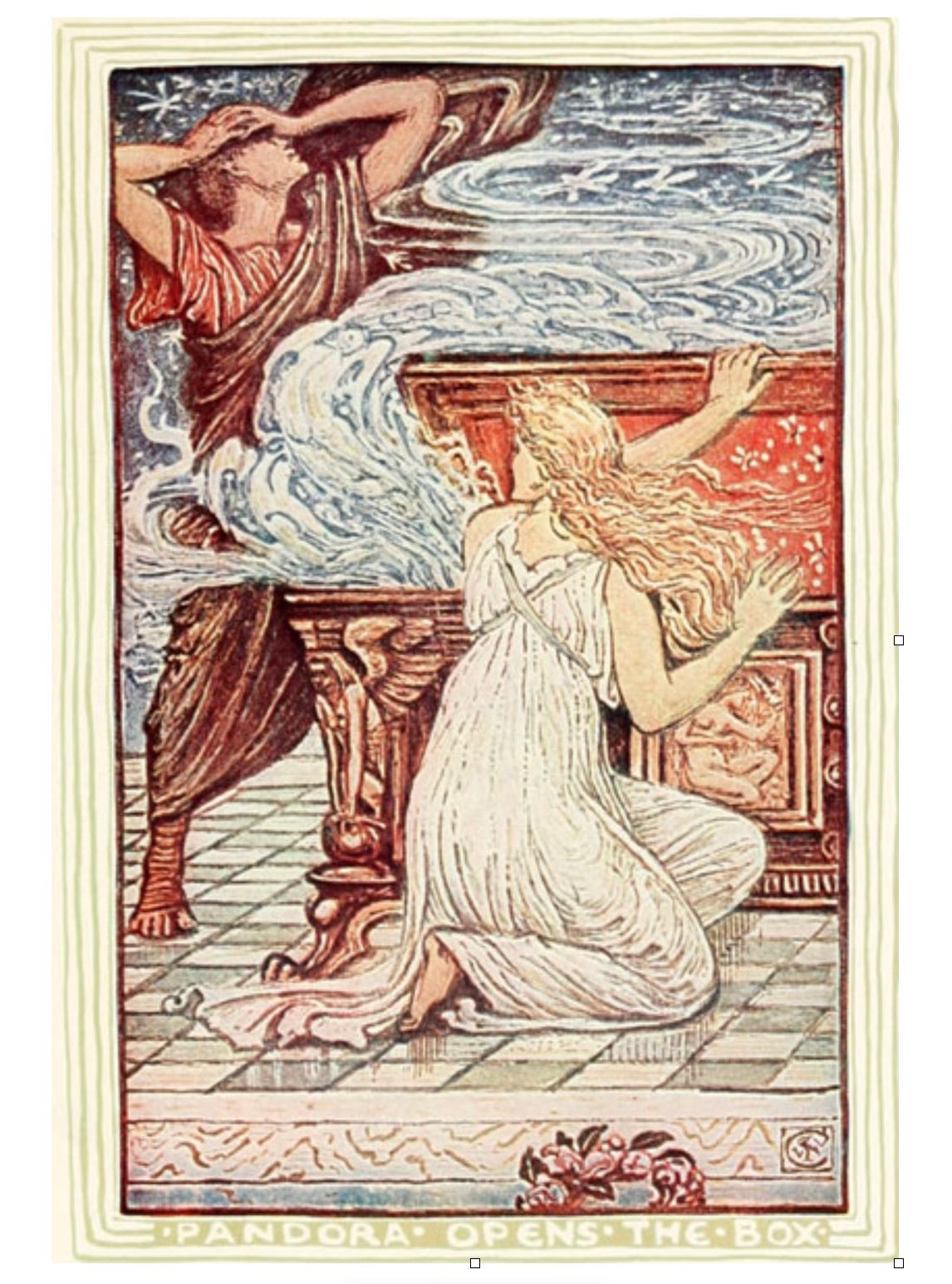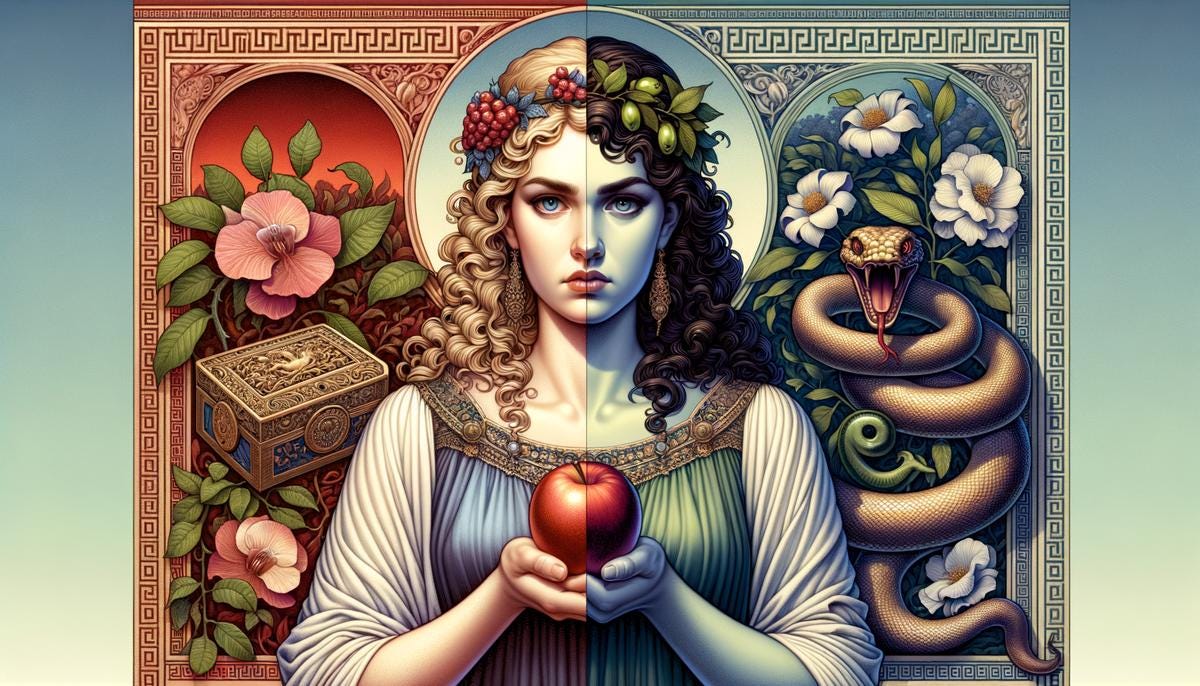You know Pandora, right?.
Pandora jewelry, the Pandora online radio station, the phrase “Opening a Pandora’s Box” all come from our sense that, way back in ancient Greek times, there was a woman named Pandora, and she was pretty special.
In fact, in the golden age of the blog (lo these many years ago), I called my own Greek mythology blog “Breakfast with Pandora” because of the name recognition.
As a child, I somehow “knew” Pandora was a girl (not a woman) who had been given a box and told not to open it. There was also a man (not a boy) named Epimetheus in the story whose name meant “Afterthought” (in contrast to his brother, Prometheus, “Forethought”). Neither the naive girl Pandora nor the imprudent grown-up Epimetheus had any chance of not opening the box.
Of course they were going to do it.
Mr. Afterthought unwisely left the girl alone with it and her curiosity soon got the best of her.
Upon opening the box, all the evils of the world flew out. Pandora was horrified and attempted to close the box, but only Hope remained inside. So, though there are many bad things in the world, at least we have hope.
I couldn’t tell you from what book I learned this. I couldn’t tell you what grade I learned it in, nor the teacher who assigned it, if anyone. I just knew.
But, it turns out, all that is mostly wrong. The true story is actually more Greek, more revealing, and more fun.
First, let’s review briefly from where that popular version of the myth came. That’s very fun.
Nathaniel Hawthorne, the famous American author of the nineteenth century who wrote The Scarlet Letter, financed his literary career by writing popular books for children.
One of them, A Wonder Book for Girls and Boys (1852), is the first book dedicated solely to making Greek mythology accessible to a young readership.
Hawthorne’s book came at a time when Americans were getting excited about a lot of ancient Greek things. A Wonder Book not only became a best seller; it made its way into the American elementary school curriculum. Still today, because of A Wonder Book and its 150-year wave of educational momentum, American schoolchildren learn about Greek mythology.
Hawthorne’s version of Pandora’s story is responsible for making Pandora into a girl and normalizing the idea that she was curious. His Pandora reflects his sense as a father that children are impulsive. If someone tells them not to touch a hot stove, they’ll do it.

But the Pandora of the original, ancient story is neither a girl, nor is she curious, nor does she open a box.
Hawthorne knew that. He actually spends a fair amount of ink winking at the adult readers of the story, admitting that he has changed some details to make the story more accessible to the young.
The real Pandora is a woman—or more specifically, a teenager ready for marriage. She comes to earth with a type of storage jar very well known to ancient Greeks, called a pithos. And she knows exactly what is in the jar, and actively opens it and dumps out the contents. There’s no sense on her part that she has done anything wrong; she closes the lid and traps hope inside, obedient to Zeus’s plan.
Here are the relevant lines from the poet Hesiod, who was writing maybe 2700 years ago:
But the woman, taking away the lid of the jar,
[dumped out and] scattered [what was in it],
for she had in mind myriad evils for men.
Only Hope remained there, in the unbreakable chamber within,
under the rim, and it did not go outside, for before it could,
she threw on the lid—by the counsels
of Zeus the cloud-gatherer, the bearer of the aegis.
…and so nothing escapes the mind of Zeus.
(translation mine, brackets indicate I have added words not in the Greek)
What’s going on here? Why did Hesiod decide to make a woman responsible for all the ills of the world?
Well, it’s not just that Hesiod hated his wife and wanted to get back at her.
We need a bit more context here.
Hesiod is very interested in Zeus. He likes Zeus. He wants to establish Zeus as the most important of the Olympians, and he is writing at a time when Greeks were developing their ideas about polytheism, and were open to being influenced by what poets decided to tell them.
And there’s a whole backstory behind Zeus’s decision to send Pandora to men (yes, men, because Pandora was the first woman!).
Mainly Zeus was getting back at Prometheus, who had fooled him in a series of tricks and thefts. Prometheus was a helper of men, and so Zeus, after punishing Prometheus, decided to punish men as accessories after the fact.
So the emphasis in Hesiod’s story is on how clever Zeus is. He commissions the creation of Pandora, asking artistic Hephaestus to sculpt her body out of clay and water, and directing the other gods and goddesses to give her attractive attributes—gifts.
Zeus even makes a point of telling Hermes, the trickster god and prince of lies, to give her a devious mind.
That’s how she gets her name Pandora, which means All Gifts.
Then Zeus tells Hermes to bring Pandora down to earth (presumably, with the mystery jar) to Prometheus’s brother Epimetheus.
Prometheus attempts to forestall Zeus’s stratagem by telling Epimetheus never to accept a gift from Zeus, but once Epimetheus sees Pandora in all her beauty (she is described as an adorned bride), Prometheus’s warnings fly away.
Hesiod’s message: Zeus, pretty rad, huh?
So the emphasis in this story is not only on Pandora as a woman who ruins everything just by being herself.1 She is Zeus’s instrument, the confirmation that he, as The Father of Gods and Men, is one hundred percent in charge.
But there’s still a couple of things to clear up, I think.
The box and the jar
What about this storage jar, thing? How did it get to be a box?
That’s a fun story, too.
A pithos is large storage jar found in every ancient Greek household. It could be as big as a small refrigerator, and it was mainly buried into the floor of a house and used to store staple foods such as grain, wine, and oil. Burying it in the floor helped to maintain a cooler and more constant temperature (and therefore to prolong the food’s freshness) in the jar.
As the centuries unfolded, the story spread into areas where the pithos was not used, and eventually, a European scholar named Erasmus mistook the Greek word pithos for the Greek word pyxis, which means a small box used to store perfume, cosmetics, or jewelry.
The mistake took on a life of its own, and so today we have the box, not the pithos.
But the pithos is very important to what the story ultimately meant to ancient Greeks.
Some scholars believe that Pandora never got the jar from Zeus, but actually tipped over and scattered a regular pithos with food in it, exposing men to hunger and the diseases associated with it.
That’s a cool theory, because Hesiod never says anything about where the jar comes from or what’s in it (see the brackets in my translation above), only that Hope is caught inside. And it takes into account the idea that the pithos was something important to ancient Greeks, important to their lives and not just a random container like a box.
I’m not convinced of that argument, just because if Hope was inside the jar, then other things that aren’t food were inside the jar, too. And the idea that the evils were let loose makes sense with another sentence that Hesiod writes:
But many evils for men roam about;
The earth is full of them, and so is the sea.(translation mine)
That word “roam” makes one think immediately of spirits. What’s more, the Greeks thought of things that affected the body as supernatural forces or beings that invaded from outside us.
(Here is a picture of Hermes supervising the coming and going of souls from a pithos, perhaps during the ancient Greek Days of the Dead:

But the idea of an empty pithos makes sense, because if you don’t have food, you can’t have life.
I personally think Hesiod chose a pithos because, like the staple foods of Greece, evils are daily realities. Food, hope, and suffering are all intimately bound up with each other.2
You wouldn’t want your evils stored in a small box—it wouldn’t be big enough.
And the fact that hope is caught inside the jar makes sense, too.
The Greeks did not believe that hope was an unmixed good, the way that we think of it today. In fact, a lot of the time they thought it was bad, because it made you blind—too optimistic, relying on good things that may not happen rather than preparing for the worst, which was a prudent thing in those very uncertain, difficult times.
So if everything in the jar was actually a bad spirit, then hope also was a bad spirit.
The only difference between the bad spirit Hope and the rest of the spirits? Hope is within our control. We can decide to hope for more or less. It’s not a disease that comes at one unawares.
If you’ve read this far, I hope (heh!) that you’ve gotten something useful or at least entertaining from what I’ve written.
But that only scratches the surface of what we can say about Pandora.
I’m also fascinated by another, similar story that comes from outside Greece: that of Eve, who in the Hebrew Bible is another first woman who, according to the author of the Book of Genesis, is around when suffering comes into the world.

I wonder whether there is some connection between Eve and Pandora. Did one story influence the other? I’ve written a lot in this newsletter about how stories from West Asia found their way to Greece and were transformed by the creativity of the ancient Greeks.
Could this be one where a Greek story has affected one from Israel?
A post for another time, after more research.
Until then, I wish you a pithos full of provisions, and therefore, full of hope.
Another story by Hesiod does imagine women as a source of ills, without worrying about jars and such.
Ironically, the Substack robot editor figured initially that when I wrote pithos in this post, I was meaning to write pathos. The Greek word pathos literally means suffering!




"I wonder whether there is some connection between Eve and Pandora. Did one story influence the other?"
The structure and similarity of the story have always made me think there's a relationship between the two. A woman doing something forbidden turns into a catastrophe. Then I did some digging, and some biblical stories bear an uncanny resemblance to mythological ones. So, I don't know. It's funny to think that some monotheistic stories could have their roots in these polytheistic mythologies.
Pandora's story is also one of the first myths I encountered as a child...specifically in a picture book from my town's public library.
It was published in the late 60s or early 70s, and in my mind the illustration of all the evil things flying out of the box/jar are intertwined with the equally freaky things we watched on "H.R. Pufnstuff" and other shows produced by Sid & Marty Krofft! 😱